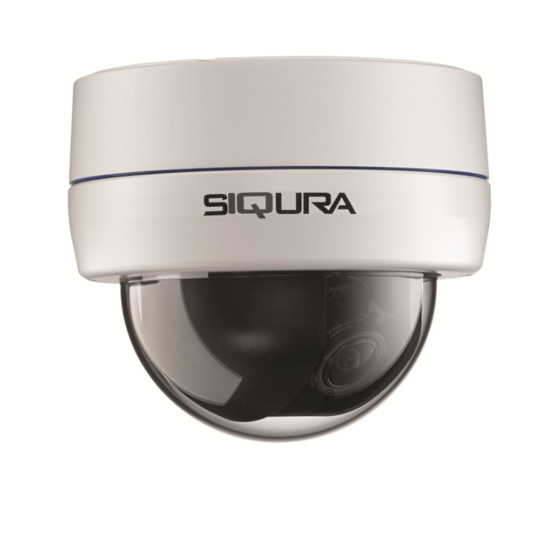Advertisement
Quick Links
Download this manual
See also:
Installation Manual
Siqura FD820M1IR-SFP
HD fixed dome camera with SFP interface
Quick Start Guide
Check package contents
Verify that your FD820M1IR-SFP package contains the following
items.
FD820M1IR-SFP
Conduit
12 Vdc Power adapter
camera
Plastic screw
Self-tapping
3-Pin connector
anchors (x5)
screws (x5)
Quick Start Guide
Security torx
Figure 1 FD820M1IR-SFP package contents
Connector overview
Figure 6 FD820M1IR-SFP Printed Circuit Board (PCB) connectors
No.
Connector
Pin
Definition
1
BNC
-
For analogue video output
2
Micro SD card slot
-
For video recording storage
3
Default button
-
Press the button to restore the defaults.
4
SFP Network
-
For SFP Cable connection
5
Network LEDs
-
Network connection and activity indication
1
Audio In (L)
2
Audio In (R)
3
GND
4
Audio Out (L)
6
Alarm & Audio I/O
5
Audio Out (R)
6
Alarm Out +)
7
Alarm Out (-)
8
Alarm In (+)
9
Alarm In (-)
7
12 V
Power
Power connector
DC 12 V
GND
8
AC1
Power-1
Power connector
GND
AC 24 V
AC2
Power-2
Table 1 FD820M1IR-SFP Printed Circuit Board (PCB) connectors description
© Siqura B.V. 2016
Version 2.1 (131211-2.1)
FD820M1IR-SFP QSG (MW10)
Find additional manuals for this Siqura product
at:
www.siqura.com/support-files
Install the camera
The fixed dome camera can be installed directly on a wall or ceiling.
Make sure that the provided surface has sufficient strength to support the
camera.
To remove the camera from the dome
1.
Make sure that the provided surface has sufficient strength to support
housing
the camera.
1.
Release the two screws indicated in
figure 2, and then open the dome
Rubber ring
cover.
2.
Press both sides of the inner cover
and remove it.
3.
Loosen the two camera-fastening
screws (figure 3) and detach the
2-Pin connector
camera housing.
To mount the dome housing
Attach the dome housing to the wall
or ceiling with the supplied screws
and screw anchors. If necessary,
replace the screws with mounting
screws that are more appropriate for
the mounting surface.
Connect to power and network
Connect power and network cables to the camera as described in
figure 6 and table 1.
To power on the camera
Plug the 12 Vdc or 24 Vac cable into the power terminal block.
To connect to network
Connect one end of the SFP cable to the SFP connector of the camera
Remarks
(see figure 6), and connect the other end of the cable to the network
switch.
Line In
Note: Check the status of the link indicator and activity LEDs. If the LEDs
are unlit, check the LAN connection.
A green LINK light indicates a good network connection.
Line Out
The orange ACT light flashes to indicate network activity.
Alarm connection
Power connection
Power connection
Figure 7 ACT and LINK network LEDs
Figure 2
2aconne
ctor
Figure 3
www.siqura.com
www.tkhsecurity-usa.com
Attach cabling
Attach the power, network, audio, and alarms cables to the back of
the camera.
To connect the cabling
1.
Run the cables through the cable
gland (figure 4).
2.
Thread the cables through the
conduit entry (figure 5).
3.
Connect the cables to the camera
body as indicated in the following
sections.
4.
Place the camera body back onto the
camera housing and tighten the
camera-fastening screws.
5.
Fasten the gland body to the
side/back conduit entry.
Note: Insert the SD card into the Micro SD
card slot before you power on the camera. If
the camera is already powered on, reboot the
camera after the SD card is inserted.
Connect audio and alarms
If microphones and speakers are implemented, the camera can be
used to provide a two-way audio channel.
Connecting an alarm device to the camera input can trigger an output
action to occur based on contact closure settings.
To connect audio
Connect the audio input and output connectors to the terminal block
on the back of the camera (figures 6 and 8).
Via the camera's Audio webpage, you can set audio streaming to full-
duplex, half-duplex, simplex, or you can disable audio streaming.
To connect an alarm device
L R
Connect the alarm relay connectors
to the terminal block on the back
of the camera (figures 6 and 8).
Use the Application, Motion
1 2 3 4 5 6 7 8 9
Detection, and Tampering
webpages to configure the alarms
Audio
as desired.
Figure 8
Audio and alarm I/O terminal block
Figure 4
Figure 5
L R +
+
GND Audio
Alarm
Alarm
In
Out
Out
In
Advertisement

Subscribe to Our Youtube Channel
Summary of Contents for Siqura FD820M1IR-SFP
-
Page 1: Quick Start Guide
AC 24 V Power-2 Figure 8 Audio and alarm I/O terminal block Figure 7 ACT and LINK network LEDs Table 1 FD820M1IR-SFP Printed Circuit Board (PCB) connectors description © Siqura B.V. 2016 www.siqura.com Version 2.1 (131211-2.1) www.tkhsecurity-usa.com FD820M1IR-SFP QSG (MW10) -
Page 2: Adjust The Lens
The Logout option signs the user out of the camera’s webpages and Flip video. The image rotates across the horizontal axis. opens the Login page. Note: You can set the IR function of FD820M1IR-SFP via the Camera menu. Mirror video. The image rotates across the vertical axis. ...

















Need help?
Do you have a question about the FD820M1IR-SFP and is the answer not in the manual?
Questions and answers